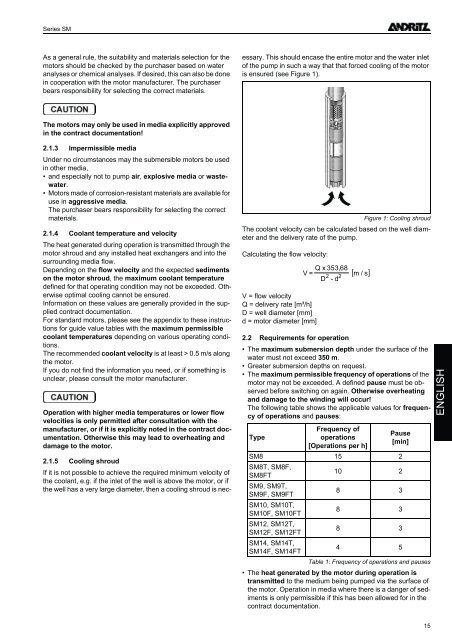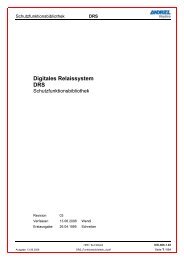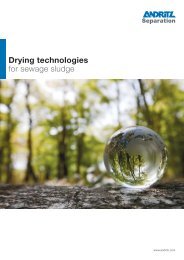Betriebsanleitung Operating Instructions Instructions de ... - Andritz
Betriebsanleitung Operating Instructions Instructions de ... - Andritz
Betriebsanleitung Operating Instructions Instructions de ... - Andritz
Create successful ePaper yourself
Turn your PDF publications into a flip-book with our unique Google optimized e-Paper software.
Series SM<br />
As a general rule, the suitability and materials selection for the<br />
motors should be checked by the purchaser based on water<br />
analyses or chemical analyses. If <strong>de</strong>sired, this can also be done<br />
in cooperation with the motor manufacturer. The purchaser<br />
bears responsibility for selecting the correct materials.<br />
2.1.5 Cooling shroud<br />
If it is not possible to achieve the required minimum velocity of<br />
the coolant, e.g. if the inlet of the well is above the motor, or if<br />
the well has a very large diameter, then a cooling shroud is necessary.<br />
This should encase the entire motor and the water inlet<br />
of the pump in such a way that that forced cooling of the motor<br />
is ensured (see Figure 1).<br />
The motors may only be used in media explicitly approved<br />
in the contract documentation!<br />
2.1.3 Impermissible media<br />
Un<strong>de</strong>r no circumstances may the submersible motors be used<br />
in other media,<br />
• and especially not to pump air, explosive media or wastewater.<br />
• Motors ma<strong>de</strong> of corrosion-resistant materials are available for<br />
use in aggressive media.<br />
The purchaser bears responsibility for selecting the correct<br />
materials.<br />
2.1.4 Coolant temperature and velocity<br />
The heat generated during operation is transmitted through the<br />
motor shroud and any installed heat exchangers and into the<br />
surrounding media flow.<br />
Depending on the flow velocity and the expected sediments<br />
on the motor shroud, the maximum coolant temperature<br />
<strong>de</strong>fined for that operating condition may not be excee<strong>de</strong>d. Otherwise<br />
optimal cooling cannot be ensured.<br />
Information on these values are generally provi<strong>de</strong>d in the supplied<br />
contract documentation.<br />
For standard motors, please see the appendix to these instructions<br />
for gui<strong>de</strong> value tables with the maximum permissible<br />
coolant temperatures <strong>de</strong>pending on various operating conditions.<br />
The recommen<strong>de</strong>d coolant velocity is at least > 0.5 m/s along<br />
the motor.<br />
If you do not find the information you need, or if something is<br />
unclear, please consult the motor manufacturer.<br />
Operation with higher media temperatures or lower flow<br />
velocities is only permitted after consultation with the<br />
manufacturer, or if it is explicitly noted in the contract documentation.<br />
Otherwise this may lead to overheating and<br />
damage to the motor.<br />
Figure 1: Cooling shroud<br />
The coolant velocity can be calculated based on the well diameter<br />
and the <strong>de</strong>livery rate of the pump.<br />
Calculating the flow velocity:<br />
V = flow velocity<br />
Q = <strong>de</strong>livery rate [m³/h]<br />
D = well diameter [mm]<br />
d = motor diameter [mm]<br />
2.2 Requirements for operation<br />
• The maximum submersion <strong>de</strong>pth un<strong>de</strong>r the surface of the<br />
water must not exceed 350 m.<br />
• Greater submersion <strong>de</strong>pths on request.<br />
• The maximum permissible frequency of operations of the<br />
motor may not be excee<strong>de</strong>d. A <strong>de</strong>fined pause must be observed<br />
before switching on again. Otherwise overheating<br />
and damage to the winding will occur!<br />
The following table shows the applicable values for frequency<br />
of operations and pauses:<br />
Type<br />
V Qx 353,<br />
68<br />
= 2 2<br />
D - d<br />
[ m/<br />
s]<br />
Frequency of<br />
operations<br />
[Operations per h]<br />
Pause<br />
[min]<br />
SM8 15 2<br />
SM8T, SM8F,<br />
SM8FT<br />
10 2<br />
SM9, SM9T,<br />
SM9F, SM9FT<br />
8 3<br />
SM10, SM10T,<br />
SM10F, SM10FT<br />
8 3<br />
SM12, SM12T,<br />
SM12F, SM12FT<br />
8 3<br />
SM14, SM14T,<br />
SM14F, SM14FT<br />
4 5<br />
Table 1: Frequency of operations and pauses<br />
• The heat generated by the motor during operation is<br />
transmitted to the medium being pumped via the surface of<br />
the motor. Operation in media where there is a danger of sediments<br />
is only permissible if this has been allowed for in the<br />
contract documentation.<br />
ENGLISH<br />
15







